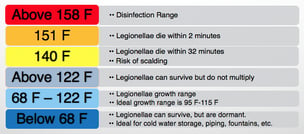Potable Water Quality
Delivering Water Quality to the Commercial and Residential Piping IndustryWater-saving strategies such as low-flow fixtures have become a vital tool in the conservation movement. But even positive changes can have unintended consequences. Water-use reduction measures can create water quality issues like fostering biofilm and Legionella growth, chemical leaching and chemical permeation.
Corzan® piping systems offer the best solution for maintaining healthy water quality by protecting against water contamination from unsafe levels of chemical leaching and permeation and reducing biofilm and the growth of Legionella.
Chemical Leaching
Plumbing products must meet a variety of federal and state drinking water quality standards, and Corzan CPVC is tested and approved per NSF/ANSI 61 to protect against water contamination. Not all plumbing materials can comply with these Federal and State water standards under all conditions. For example, in soft water (pH below 6.5), copper piping may leach metallic contaminants above the recommended limit for safe drinking water.
Corzan CPVC is routinely tested to the highest standards for water quality. They fully comply with NSF 61, NSF 14 and will not cause the water to fail other state-level drinking water regulations under typical water conditions.
Chemical Permeation
Some common plumbing systems are subject to chemical permeation, meaning contaminants coming in contact with the outside of the pipe may be transmitted through the pipe wall leading to water contamination. Corzan CPVC has superior permeation resistance and is backed by the FBC™ System Compatible Program to assist manufacturers of ancillary products in determining their product’s chemical compatibility with Corzan piping systems.
Biofilm Formation
Lower water flow rates mean water is staying in pipes three to four times longer, and longer stagnation times can cause chlorine residuals to dissipate. Without chlorine residuals, biofilm growth can occur, serving as a safe harbor for bacteria such as Legionella, Pseudomonas, E.coli and other coliforms.
What is Legionella?
Identified in 1976 after a deadly outbreak of disease at a meeting of the American Legion, Legionella causes legionellosis, which can lead to a serious form of pneumonia called Legionnaires' disease, the less-deadly Pontiac fever and Pittsburgh pneumonia. Legionellosis is contracted not from person-to-person contact but through inhalation of mist or vapor contaminated with the Legionella bacteria. Harmful bacteria like Legionella and E.coli thrive in biofilms, the slimy, glue-like substances that form on piping materials when biomass adheres to surfaces in wet environments. Biofilm also protect the bacteria from thermal and oxidative disinfection methods.
Research Results: Biofilm Growth and Internal Surface Comparisons
CPVC has the lowest level of potential biofilm growth among competing materials:

*Source: Biofilm Formation Potential of Pipe Materials in internal installations; H.R. Veenendaal/D. van de Kooiy; KIWA; 1999
Materials like stainless steel and copper have or eventually develop an uneven surface conducive to biofilm growth. Corzan CPVC is resistant to biofilm and Legionella growth due to the smooth, consistent, rigid surface of the material through its entire lifecycle. The images below show a topological view of the material’s surface (left) and a close-up of the same (right). Green and blue colors represent a flat, smooth surface, where orange and red indicate an uneven surface that creates opportunities for biofilm formation. Corzan CPVC is overwhelmingly green, whereas a material like galvanized iron is mostly red.
Corzan CVPC

Stainless Steel

Galvanized Iron

Piping Material Comparisons – New Copper

Piping Material Comparisons – Aged Copper

ASHRAE Guideline 12-2000
ASHRAE Guideline 12-2000 establishes minimum legionellosis risk management requirements for building water systems. Guideline 12-2000 is essential for anyone involved in design, construction, installation, commissioning, operation, maintenance and service of centralized building water systems and components.
This table shows the temperature of water in a system and the corresponding conditions for Legionella:

Corzan piping systems safely withstand ANSI/ASHRAE 12-2000-compliant decontamination procedures. Unlike PEX, PP-R and other plastics, Corzan CPVC can withstand the high-temperature chlorinated water required for Legionella remediation, and unlike copper, Corzan CPVC isn’t susceptible to rapid corrosion caused by the effects of shock chlorination.
Webinar: Reducing the Risk of Legionella Growth in Piping Systems
Case Study: The Potential Health Hazard of PP-R Pipe Degradation in Potable Water Delivery
Unlike PP-R, Corzan® CPVC is naturally resistant to commonly used disinfectants such as chlorine, choramine and chlorine dioxide in U.S. drinking water systems. A recent case study involving a Southern California multi-family complex revealed how PP-R pipes, which had deteriorated over a decade, were replaced with Corzan® CPVC piping.